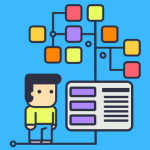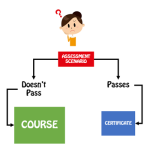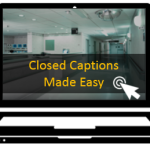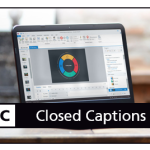Step Away from that Content
February 2nd, 2021
Instructional design isn’t really that complicated. At its core, it’s about teaching something to someone who acquires new skills and knowledge and can apply them to meet some objective.
The challenge with a lot of e-learning is that courses are designed to be presentations of content, but not focused enough on the teaching and application. Content is obviously a key component of learning. But learning is a process where the content is synthesized with experience, activities, and feedback to do something new or perhaps better. Just looking at content with no application of what’s learned is a deficient instructional design process.
Content by itself is mostly irrelevant. Content pasted into an authoring tool doesn’t make it a course or great learning experience. The e-learning course isn’t the objective. The objective is to accomplish something specific, and the course is part of the solution to do that.
Step Away from the Solution
When I first learned about instructional design, we focused on backwards design where we looked at observable skills and then what was required to get the person there.
The natural inclination is to package content. But you need to step away from content. Instead look at what actions are required of the learner and then step backwards into the content. Here’s a simple way to think about backwards design.
In the real world:
- What does the person need to do?
- How do they demonstrate that they can do it?
- How do they practice the skills required to demonstrate them?
In the e-learning course:
- How do they demonstrate their understanding in the course? What assessment activities can you create?
- What practice activities can you build for them to practice the skills?
- How much do they need to learn to practice?
- What content do they need to learn so that they can practice?
This is a simplified version of backwards design. The main focus is on the desired action and not content. What does the learner need to do? How do they practice it? What do they need to know? At some point you get to the content that supports the activity. This is how you get to the right content for the course versus just a content dump that becomes the course.
As you can see, focusing on action gets you to performance. And content is there to support what needs to be learned. You don’t start with content because it’s not tied to an action. And that’s where most courses fail.
The next time you build a course, identify the measurable performance expectations. What do they need to do? And then build backwards which will help determine the content you need.
Events
- Everyday. Check out the weekly training webinars to learn more about Rise, Storyline, and instructional design.
Free E-Learning Resources
 |
 |
 |
|
Want to learn more? Check out these articles and free resources in the community. |
Here’s a great job board for e-learning, instructional design, and training jobs |
Participate in the weekly e-learning challenges to sharpen your skills |
 |
 |
 |
|
Get your free PowerPoint templates and free graphics & stock images. |
Lots of cool e-learning examples to check out and find inspiration. |
Getting Started? This e-learning 101 series and the free e-books will help. |









0
comments